Regression
- Stock Market Forecast
$$ f(“股票数据”) = Dow\ Jones\ Industrial\ Average\ at\ tomorrow $$
- Self-driving Car
$$ f(“无人车的Sensor”) = 方向盘角度 $$
- Recommendation
$$ f(“使用者A\ \ 商品B”) = 购买可能性 $$
Example Application
-
Estimating the Combat Power (CP) of a pokemon after evolution
用$x$代表宝可梦,其中$x_{s}$代表宝可梦的名称,$x_{cp}$,$x_{w}$代表重量,$x_{h}$代表身高。
$$ f(“宝可梦的参数\rightarrow x”) = “CP\ after \ evolution \rightarrow y” $$
Step 1: Model
-
A set of function 去描述一个Model:
$$ y = b + w\cdot x_{cp} $$
$w$ and $b$ are parameters (can be any value), eg:
$$f_1:y=10.0+9.0\cdot x_{cp} \f_2:y=9.8 + 9.2\cdot x_{cp} \f_3:y=-0.8-1.2\cdot x_{cp} \……$$
用以上去描述宝可梦的函数式:
$$f(x)=”CP\ after\ evolution” \rightarrow y$$
这叫做 Linear model,
$$ y = b + \sum{w_ix_i} $$
其中,$x_i$:An attribute of input x, 用来描述
feature,$w_i$:weight,$b$: bias 。 -
Step 2: Goodness of Function
引入一些数据来作为 $y=b+w\cdot x_{cp}$ 的 input,比如,第一个数据为杰尼龟的数据,用$x^1$来表示第一个数据的数据集,对应的 output ,即卡咪龟的数据集,用 $\hat{y}^1$ 代表。其他数据以此类推。
接下来的 Training Data 假设就是 10 只宝可梦。即,
$$(x^1, \hat{y}^1)\\ (x^2, \hat{y}^2)\… \(x^{10},\hat{y}^{10})$$
对应图像如下,
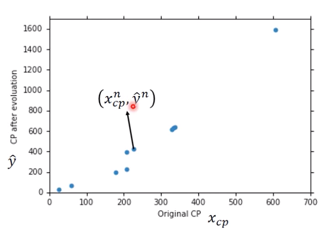
图中任意一点的值为 $(x^n_{cp}, \hat{y}^n)$。
在有了 training data 以后,需要定义另一个Loss function $L$: 其中input 为对应的 function,output 即为 how bad it is,即:
$$L(f) = L(w, b)\\ =\sum^{10}{n=1}(\hat{y}^n - (b+w\cdot x^n{cp}))^2$$
衡量参数的好坏, 即$w$ 和$b$ 的好坏,
其中里面的括号中为 Estimated y based on input function,而 $\hat{y}^n$即为真实至,而$L(f)$则给出 Estimation error。
$\sum$来 Sum over examples。
图像为,
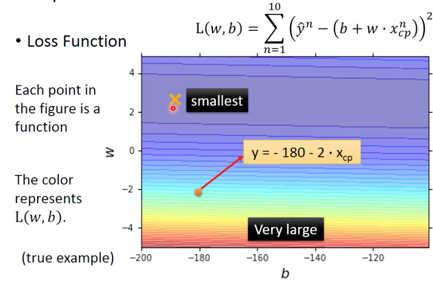
-
Step: Best Function
在建立了 A set of function 之后,要 pick the BEST Function,
$$\begin{aligned}f^{}=& \arg \min _{f} L(f) \w^{}, b^{*} &=\arg \min {w, b} L(w, b) \&=\arg \min _{w, b} \sum{n=1}^{10}\left(\hat{y}^{n}-\left(b+w \cdot x_{c p}^{n}\right)\right)^{2}\end{aligned}$$
可以利用 Gradient Descent 来解这个 function。
-
Step 3: Gradient Descent,来解$w^{*}=\arg \min_{w}L(w)$
- Consider loss function $L(w)$ with one parameter w:
-
首先随机选一个起始值 $w^0$
-
Compute
$$\left.\frac{dL}{dw}\right _{w=w^0}$$ 用图像来表示即为,
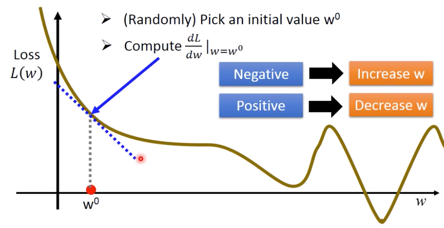
寻找下一个$w^1$的值,即为
$$w^1 \leftarrow w^0 - \left.\eta \frac{dL}{dw}\right _{w=w^0}$$ 其中 $\eta$ 被称为 “learning rate“,越大学习速度越快。
-
下一步重复 Compute $$\left.\frac{dL}{dw}\right| _{w=w^1}$$
-
… Many iterations ( T times )
这时候的情况如下图:
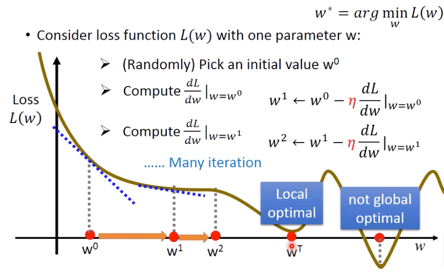
这时获得了 Local optimal $\rightarrow w^T$,但注意是并非 Global optimal 。
-
-
如果有两个参数呢?
对应公式如下,
$$w^, b^ = \arg \min_{w, b}L(w, b)$$
-
随机 Pick an initial value $w^0, b^0$
-
Compute
$$\left.\frac{\partial L}{\partial w}\right _{w=w^{0}, b=b^{0}},\left.\frac{\partial L}{\partial b}\right _{w=w^0, b=b^0}$$ - 分别更新 $w$ 与 $b$ 的值
$$ w^1 \leftarrow w^0 - \left.\eta\frac{\partial L}{\partial w}\right _{w=w^0, b=b^0}\ b^1 \leftarrow b^0 - \left.\eta\frac{\partial L}{\partial b}\right _{w=w^0, b=b^0}$$ - Compute
$$ \left.\frac{\partial L}{\partial w}\right _{w=w^1, b=b^1}, \left.\frac{\partial L}{\partial b}\right _{w=w^1, b=b^1}$$ - 再次更新 $w$,$b$ 的值
$$ w^2 \leftarrow w^1 - \left.\eta\frac{\partial L}{\partial w}\right _{w=w^1, b=b^1}\ b^2 \leftarrow b^1 - \left.\eta\frac{\partial L}{\partial b}\right _{w=w^1, b=b^1}$$ -
反复重复这个步骤最终获得 loss 相对比较小的 $w$ 和 $b$ 的值
-
而 $\nabla L$ 即为 gradient :
$$\nabla L=\left[\begin{array}{l}\frac{\partial L}{\partial w} \\ \frac{\partial L}{\partial b}\end{array}\right] _\text { gradient }$$
其中,将两个偏微分排成一个 vector- 示意图如下,
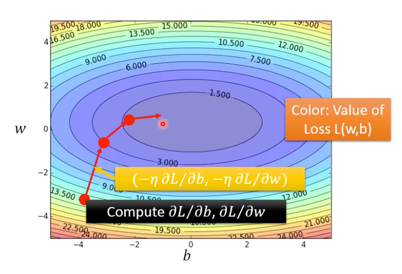
其中每一次的 gradient 即为等高线的法线法向。
- 但用这种方法,会出现问题,即如下图左侧所示,如果起点不同可能会找到不同的输出值,但实际上,利用这种方法是不会产生 local optimal 的
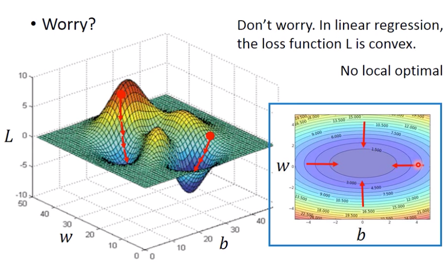
- Formulation of $\partial L / \partial w$ and $\partial L / \partial b$,即为
$$\begin{array}{l}L(w, b)=\sum_{n=1}^{10} ({\left.\hat{y}^{n}-\left(b+w \cdot x_{c p}^{n}\right)\right)^{2}} \\\frac{\partial L}{\partial w}=? \sum_{n=1}^{10} 2\left(\hat{y}^{n}-\left(b+w \cdot x_{c p}^{n}\right)\right)\left(-x_{c p}^{n}\right) \\\frac{\partial L}{\partial b}=? \sum_{n=1}^{10} 2\left(\hat{y}^{n}-\left(b+w \cdot x_{c p}^{n}\right)\right)(-1)\end{array}$$
-
-
How’s the results?
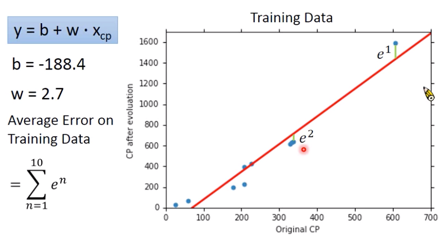
Error 值即为真实值与预测值之间的距离。可以获得 Average Error on Training Data为,
$$ \sum_{n=1}^{10}e^n = 31.9 $$
-
但是真正关心的应该是 Generalization,What we reaaly care about is the error on new data (testing data)
于是又取了十只 Pokemon,情况如下
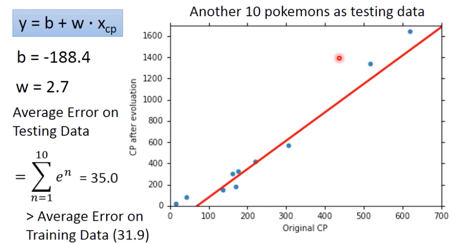
而新的数据中的 Average Error on Training Data 为 35.0
-
How can we do better
-
从上图中可见在CP较低和较高的区域,拟合不好,于是我们选择令 Selecting another Model
$$ y = b+ w_1\cdot x_{cp}+w_2\cdot (x_{cp})^2$$
找出 Best function,这时
$$ b= -10.3, \w_1=1.0, w_2=2.7*10^{-3}\\ \text{Average Error} = 18.4$$
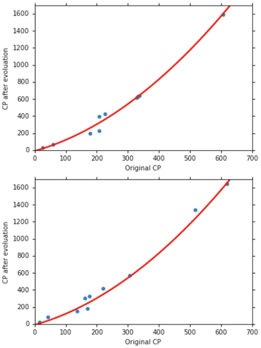
重新取 10 只 Pokemon 得出,Average Error = 18.4
-
Better! Could it be even better?
引入更复杂的model,
$$ y = b + w_1 \cdot x_{cp}+w_2\cdot (x_{cp})^2 + w_3\cdot (x_{cp})^3$$
找出 Best Function,
$$ b=6.4, w_1=0.66\\ w_2=4.310^{-3},\\ w_3=-1.81-^{-6}, \Average Error = 15.3$$
同样重新取 10 只 Pokemon ,得出 Average Error = 18.1
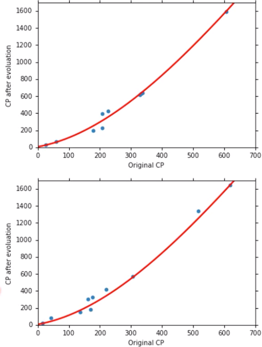
-
用同样的方法,Try to make it better
$$ y = b + w_1\cdot x_{cp}+ w_2\cdot (x_{cp})^2 + w_3\cdot (x_{cp})^3 + w_4\cdot (x_{cp})^4$$
并获得图像,
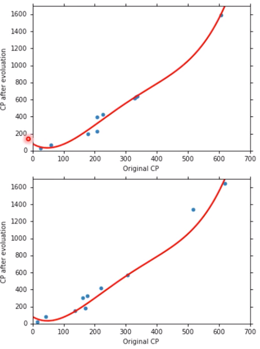
这时的 Average Error = 14.9,但重新取 10 只 Average Error = 28.8 变得比之前更高了
-
继续使用更加复杂的 Model,结果会变得更加糟糕
$$ y = b+w_1\cdot x_{cp} +w_2\cdot (x_{cp})^2 + w_3\cdot(x_{cp})^3 + w_4\cdot (x_{cp})^4 + w_5\cdot (x_{cp})^5 $$

-
分析这 5 个 Model,对这5次的 Training Data 的 Average Error 进行统计,如下图
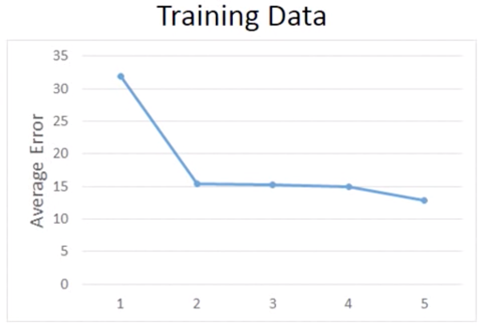
这是因为更复杂的 Model 的 Function Space 会包含低级的 Model Space,如下图描述

但如果针对于,Testing Data,则情况会不同,
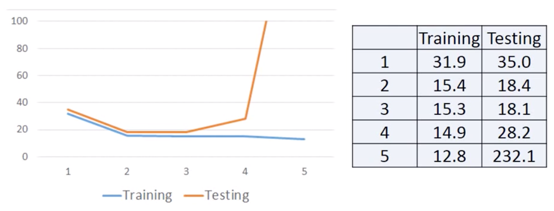
A more complex model does not always lead to better performance on testing data, This is Overfitting.
而当 Model 的复杂程度在第 4 次和第 5 次时,就发生了 Overfitting。
-
- Consider loss function $L(w)$ with one parameter w:
-
What are the hiden factors?
在计算CP值时,前面的 input 数据选用的只有杰尼龟一种,一旦要是,但是要去 make a more general model,就要考虑Pokemon的种类这一问题。
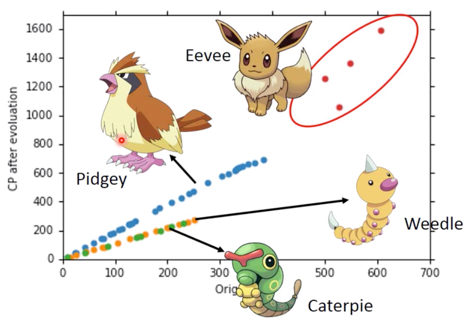
如何解决这个问题呢?
-
Back to step 1: Redesign the fuction set of the Model
可以套用
if语句: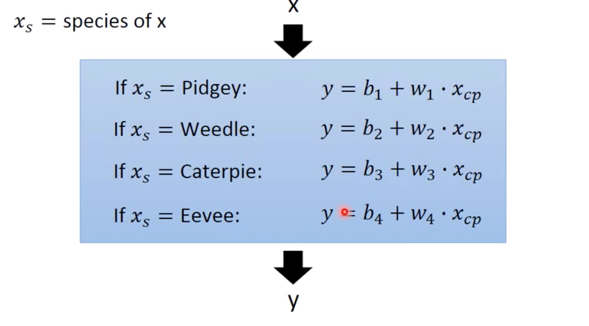
接下来,我们需要将加入
if语句的 Model 改写为 Linear model ($y=b+\sum{w_i x_i}$):$$\begin{aligned}y=& b_{1} \cdot \delta\left(x_{s}=\text { Pidgey }\right) \&+w_{1} \cdot \delta\left(x_{s}=\text { Pidgey }\right) x_{c p} \&+b_{2} \cdot \delta\left(x_{s}=\text { Weedle }\right) \&+w_{2} \cdot \delta\left(x_{s}=\text { Weedle }\right) x_{c p} \&+b_{3} \cdot \delta\left(x_{s}=\text { Caterpie }\right) \&+w_{3} \cdot \delta\left(x_{s}=\text { caterpie }\right) x_{c p} \&+b_{4} \cdot \delta\left(x_{s}=\text { Eevee }\right) \&+w_{4} \cdot \delta\left(x_{s}=\text { Eevee }\right) x_{c p}\end{aligned}$$
其中,
$$ \delta(x_s = Pidgey) \ \ \left{\begin{array}{ll}=1 & \text { If } x_{s}=\text { Pidgey } \\ =0 & \text { otherwise }\end{array}\right.$$
这样就有:
$$ if \ x_s = Pidgey,\\ y = b_1 + w_1\cdot x_{cp} $$
其中,
$$\delta(x_s = Pidgey)$$
这一项即为 Linear model 中的 $x_i$,也就是 feature
引入不同 $x_s$ 后的分析图像如下图,
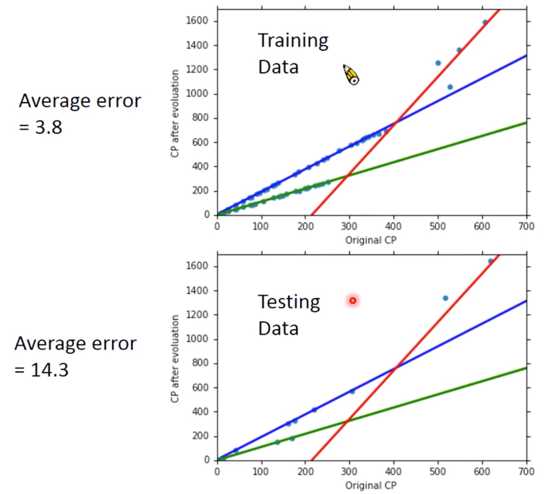
从图中可见,不考虑伊布的曲线fit的不好,是因为伊布可以进化为不同的精灵,但其他宝可梦也有一些或多或少fit不好的情况,可能是进化时候加了一个 random number,但也可能不是 random number,也可能有其他factors
-
Are there any other hidden factors?
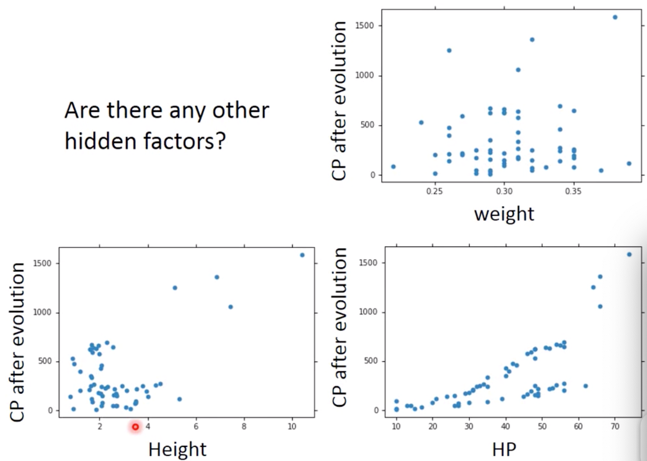
对待这个问题,有可能是很多因素导致的,如 weight,HP 等等,那么如何解决这个问题呢?我们可以将所有的能考虑到因素加进去:
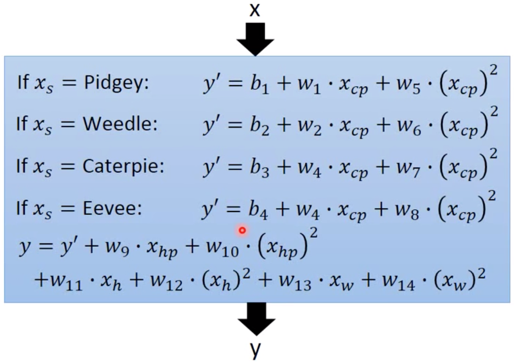
这么复杂的 Model 给出了很低的 Training Error = 1.9,但Testing Error 却非常糟糕 = 102.3,发生了严重的 Overfitting。
解决这个问题,我们要引出下一个概念:
-
Back to step 2: Regularization,重新定义我们的 Loss Function,将不好的去掉
即在原有的 Loss function 后添加一项:
$$ L = \sum_n(\hat{y}^n - (b + \sum{w_i x_i}))^2 + \lambda \sum(w_i)^2$$
而这个 $\lambda\sum(w_i)^2$ 项,The functions with smaller w_i are better
Why smooth functions are preferred?
比如我们在 input $x_i$ 的基础上,增加为 $x_i + \Delta x_i$,则此时 对于 $y=b+\sum w_i x_i$ output 变为 $w_i\Delta x_i$,则当 $w_i$越小,input 对 output 影响越小,这样 function 也就会比较平滑
If some noises corrupt input $x_i$ when testing,也就是是说 function 如果变得不平滑了,A smoother function has less influence。
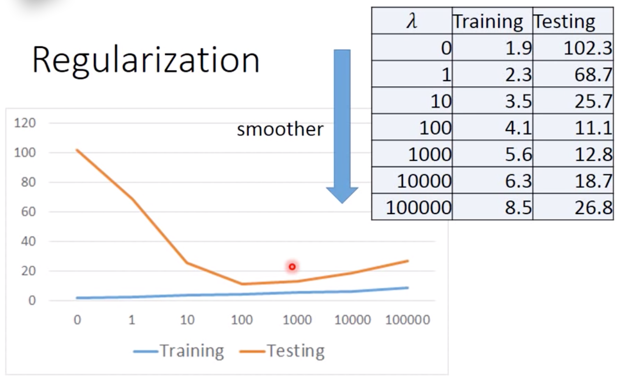
首先可以确定,当 $lambda$ 越大,function 越平滑,但 function 越平滑,Traning data error 越大,这是因为:Larger $lambda$,considering the training error less,越倾向于考虑 $w_i$ 本来的值。
但 Testing error 却发生不同的变化,可见:We prefer smooth function, but don’t be too smooth。
所以我们需要调整一个较好的 $\lambda$,这是非常重要的。
-
另外需要注意的是,对于 Regularization 项:
$$\lambda\sum(w_i)^2$$
只包含有 $w_i$,但却没有 $b$,其实在考虑 Regularization时,不需要考虑 bias。因为加 bias 只会对 function 进行平移,不会影响 function 的平滑度。
-
-
Conclusion:
-
Gradient descent
- Following lectures: theory and tips
-
Overfitting and Regularization
- Following lectures: more theory behind these
-
We finally get average error = 11.1 on the testing data
-
How about another set of new data? Underestimate? Overestimate?
-
Following lectures: validation 来解决上面的问题。
-
-
Basic Concept - Where does the error come from?
在之前的实例中,我们发现选择不同的 Function Set,也就是选择不同的 Model,往往会给出不同的 Average error,而且越复杂的 Model,不见得会给出越低的 Error。
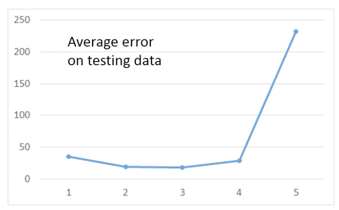
而其中 error 有两个来源:
- 来自于 “bias”
- 以及 “variance”
Estimator
对于一个 Estimator, 如
$$\hat{y} = \hat{f}(\text{Pokemon CP})$$
From this training data, we find $f^*$ ,那么有 $f^*$ is an estimator of $\hat{f}$。二者关系可以用下图表示,
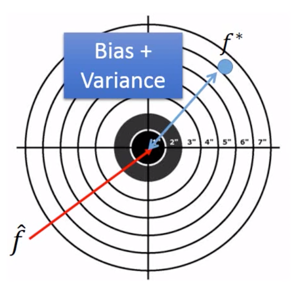
靶标的中心点是 $\hat{f}$,而 $f^*$ 则在偏离靶中心的位置,而这个偏离,就是又 Bias 以及 Variance 共同决定的。
Bias and Variance of Estimator
-
Estimate the mean of a variable x
- assume the mean of x is $\mu$
- assume the variance of x is $\sigma^2$
-
Estimator of mean $\mu$
-
Sample N points: ${x^1, x^2, …, x^N}$
$$ m = \frac{1}{N}\sum_n{n^n} \neq \mu$$
这时 $m$ 和 $\mu$ 的值是不相等的,示意图如下

-
但是如果我们计算这些 $m$ 的期望值,就会得到我们想要的 $\mu$
$$E[m] = E\biggl[\frac{1}{N}\sum_n x^n\biggr] = \frac{1}{N}\sum_n E[x^n] = \mu$$
这个问题就像打靶,每次打靶都会偏离中心,但当打靶次数足够多,最终这些偏离中心的打点的中心就是最终的期望。
-
这个散布在期望周围, 散的有多开取决于 $m$ 的 Variance ,这个 Variance 的表达式为,
$$Var[m] = \frac{\sigma^2}{N}$$
Varicance depends on the number of samples,如图所示
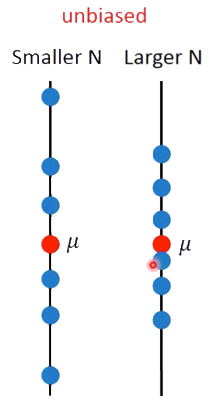
-
-
Estimator of variance $\sigma^2$
-
Sample N points: {$x^1, x^2, …, x^N$}
-
首先估计 $m$ 的值,
$$ m = \frac{1}{N}\sum_n x^n $$
-
之后再计算估计 $s^2$,
$$ s^2 = \frac{1}{N}\sum_n (x^n - m)^2 $$
这个 $s^2$ 可以用来估计 $\sigma^2$
但是,需要注意,这个对于 $\sigma ^2$ 的估计是Biased estimator,
$$ E[s^2] = \frac{N-1}{N} \sigma ^2$$
也就是说 $s^2$ 的期望值并不正好等于 $\sigma^2$ ,如果我们增加样本量,这一现象就会减轻:
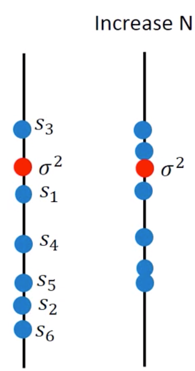
用打靶来描述这件事情,如下图
-
-
-
Parallel Universes
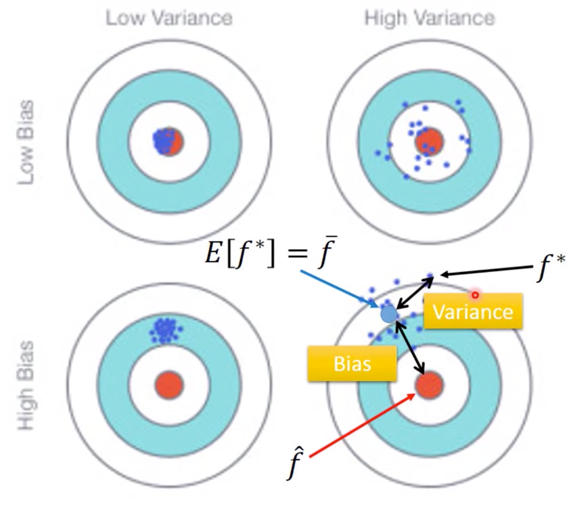
而打靶打的准或不准是由 Variance 和 Bias 两部分共同决定的。
Variance
In all the universes, we are collecting (catching) 10 Pokemons as training data to find $f^*$
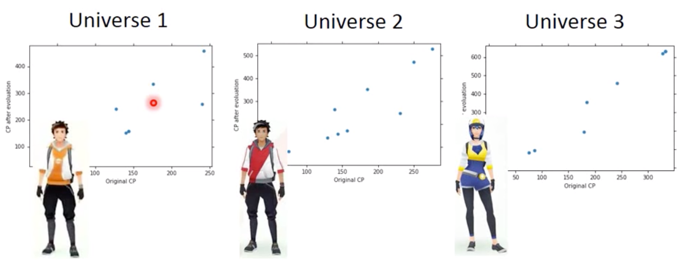
我们在不同宇宙中抓到的宝可梦是不一样的。
In different universes, we use the same model, but obtain different $f^*$
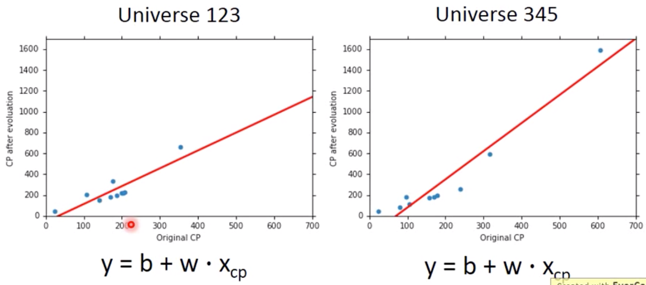
最终的结果如果我们用越来越复杂的 model ,就会给出越来越崩溃的结果,
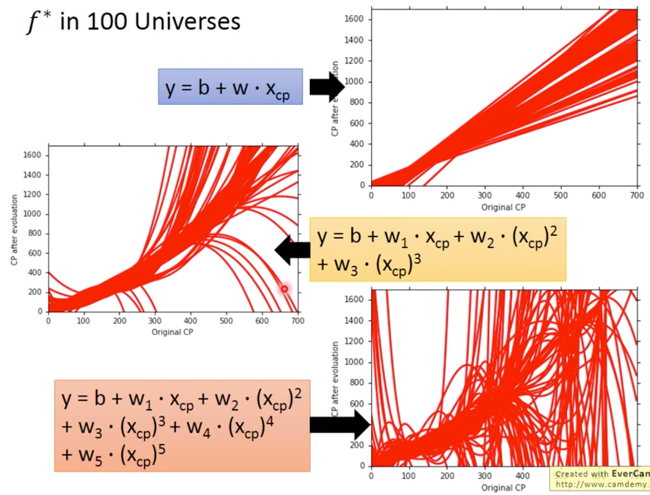
而这几种越来越复杂的 model 所带来的混乱的情况,用打靶来形容,如下图所示,
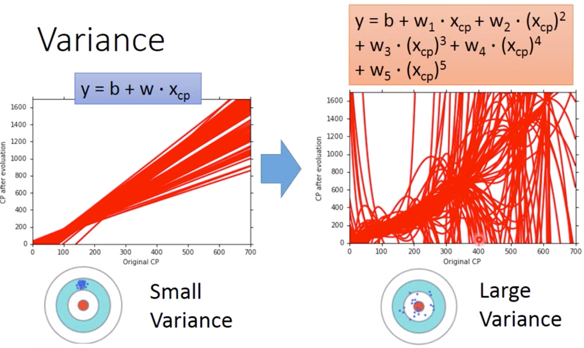
可以看出,越简单的 model,对应的 Variance 越小,这可以认为是因为,Simpler model is less influenced by the sampled data 。可以考虑一个极端的例子:
$$ f(x) = c $$
对于这个常值函数的 model,其 Variance = 0,不会受到 sampled data 影响。
Bias
$$ E[f^*] = \overline{f}$$
-
Bias: If we average all the $f^*$, is it close to $\hat{f}$
-
先引入打靶问题,来描述 Bias 大小对于靶标的影响,
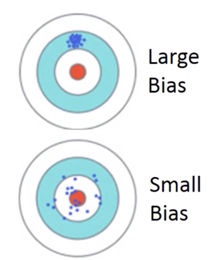
可见,如果 Bias 很小,即使数据很离散,其平均值 $\overline{f}$ 也会很接近 $\hat{f}$。
-
下面需要确定一条 $\hat{y}$,我们只能先假设一个 $\hat{f}$
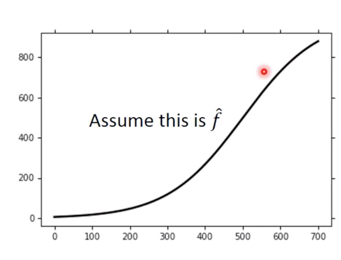
-
然后我们分别对不同复杂程度下的 model 给出的 $\overline{f}$ 与 $\hat{f}$ 之间的关系,如下图
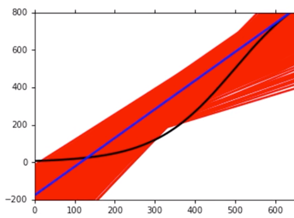
-
上图是描述一次的 Model,图中曲线标注情况如下:
Black curve: the true function $\hat{f}$
Red curves: 5000 $f^*$
Blue curve: the average of 5000 $f^* = \overline{f}$
-
当考虑一个较为复杂的三次 Model,如下图
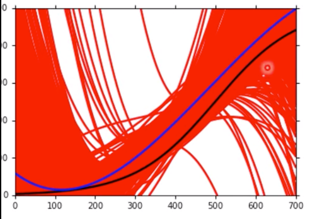
虽然单独每一次和 $\hat{f}$ 可能相差很多,但平均下来与 $\hat{f}$ 却较为接近。
-
当复杂程度继续升高,即考虑五次的 Model,$\overline{f}$ 则进一步趋近于 $\hat{f}$,如下图所示:
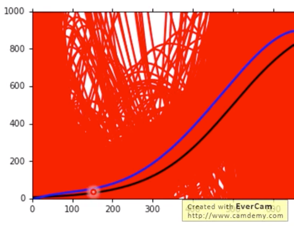
-
-
对于以上现象,可以从 function space 的角度来解释,即如果 Model 没有那么复杂,它对应的 function space 就相对较小,可能并没有包含 Target,如下图,
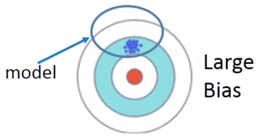
相反如果 Model 比较复杂,对应上述 5 次的 Model,其 function space 较大,就可能包含了 Target,如下图,
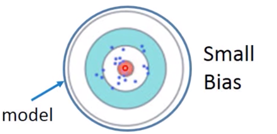
What to do with large bias?
综合起来,存在两种 error,即:
- Error from bias
- Error from variance
这两种对应的 Error 的关系如下图,
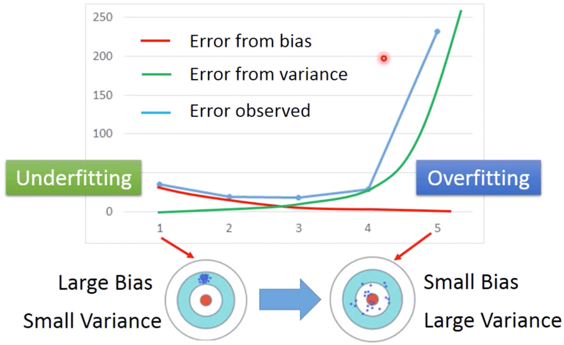
而由于 bias 引起 Error,我们称之为 Underfitting ;由于 variance 引起的 Error,我们称之为 Overfitting。
-
Diagnosis:
-
If your model cannot even fit the training examples, then you have large bias: Underfitting
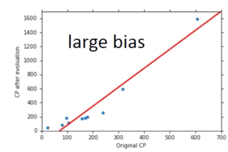
-
If you can fit the training data, but large error on testing data, then you probably have large variance: Overfitting
-
-
For bias, redesign your model:
-
Add more features as input
-
A more complex model
-
What to do with large variance?
-
more data

It’s very effective, but not always practical. 也可以根据经验给一个经验的 Model
-
Regularization
通过 Regularization,使得曲线更加平滑,如下图所示:

但是这样做,会伤害到 bias
Model Selection
-
There is usually a trade-off between bias and variance.
-
Select a model that balances two kinds of error to minimize total error
-
What you should NOT do:

注意不要直接选择 Model 3,因为绿色的 Testing Set 本身有着自己的 bias,而与实际上的 橙色的 Testing Set 不同 ( $Err > 0.5$ )。
为了更好的理解这个问题,给出下面的举例:Homework 中的情况
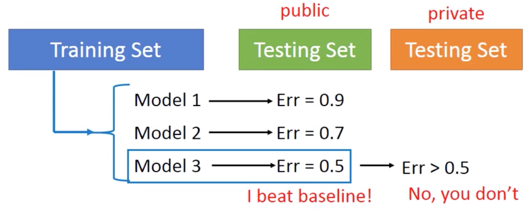
更好地理解,比如说小明在班级里排名第一,但在全校可能排不上名次。
那么如何解决这个问题呢?
Cross Validation
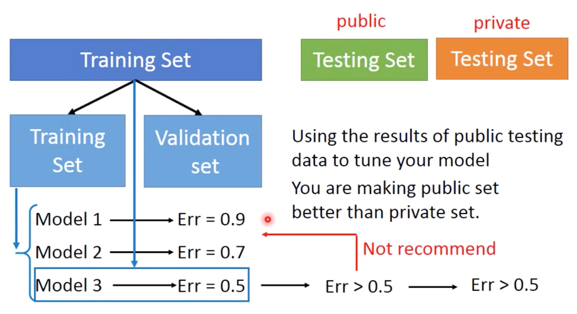
- 可以将 Training Set,分成两部分,即 Training Set 和 Validation Set
- 再通过新的 Training Set 计算出 Error 以后,选出最佳的 Model
- 再将全部 Training Set 加进去,计算public Tesing Set 的 Error,这时的 Error 会比之前的 Error 更大,但更加接近真实的 private Testing Set。
- 但不建议在知道 pulic Error 很大以后,再返回去修改前面的 Model,因为这样会引入这次 Public Testing Set 中的 bias。
-
Using the results of public testing data to tune your model
-
You are making public set better than private set,在 public 看到的 performance 没办法反应在 private 上的 performance了
如果将 Training Set 分开 Validation Set 时,发现 Validation 的 bias 也有问题怎么处理呢?
N-fold Cross Validation
如果你不相信某一次 Training 结果,可以按下图方式进行:
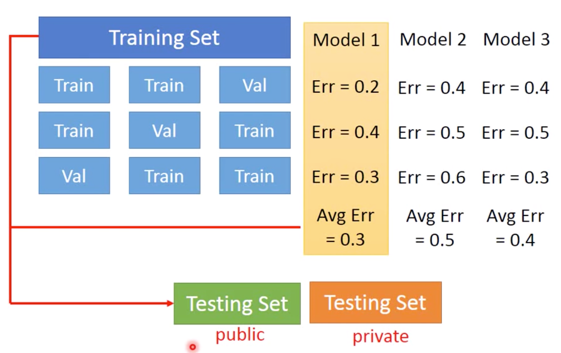
利用这种方法,根据三次实验后的 Average Error,再去进行比较。原则上,少去根据 Testing Set 调整 Model 的话,往往最终得到的 Testing Set 会比较小。